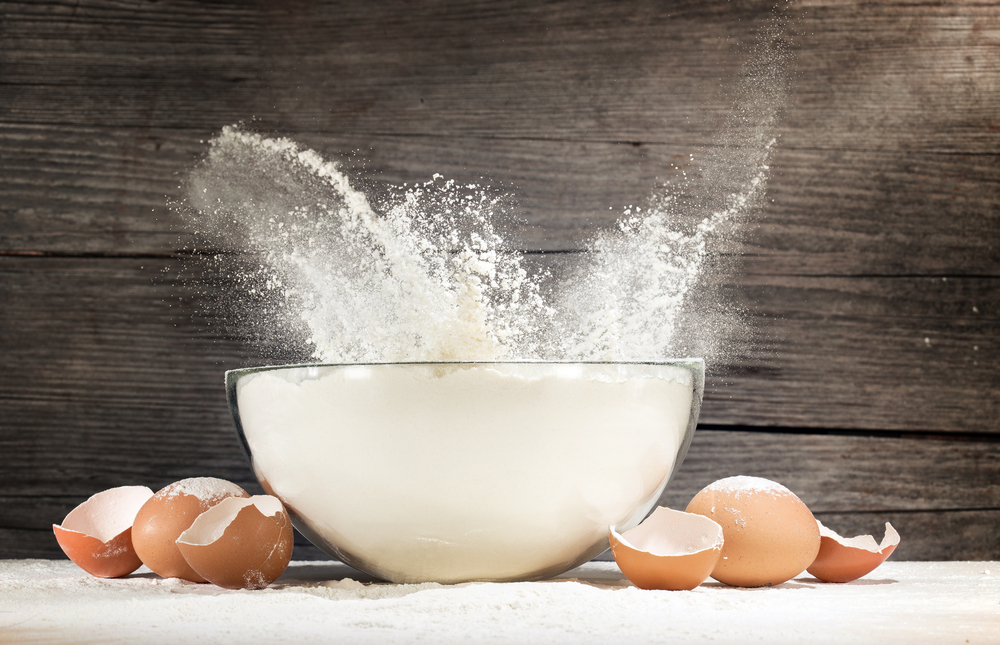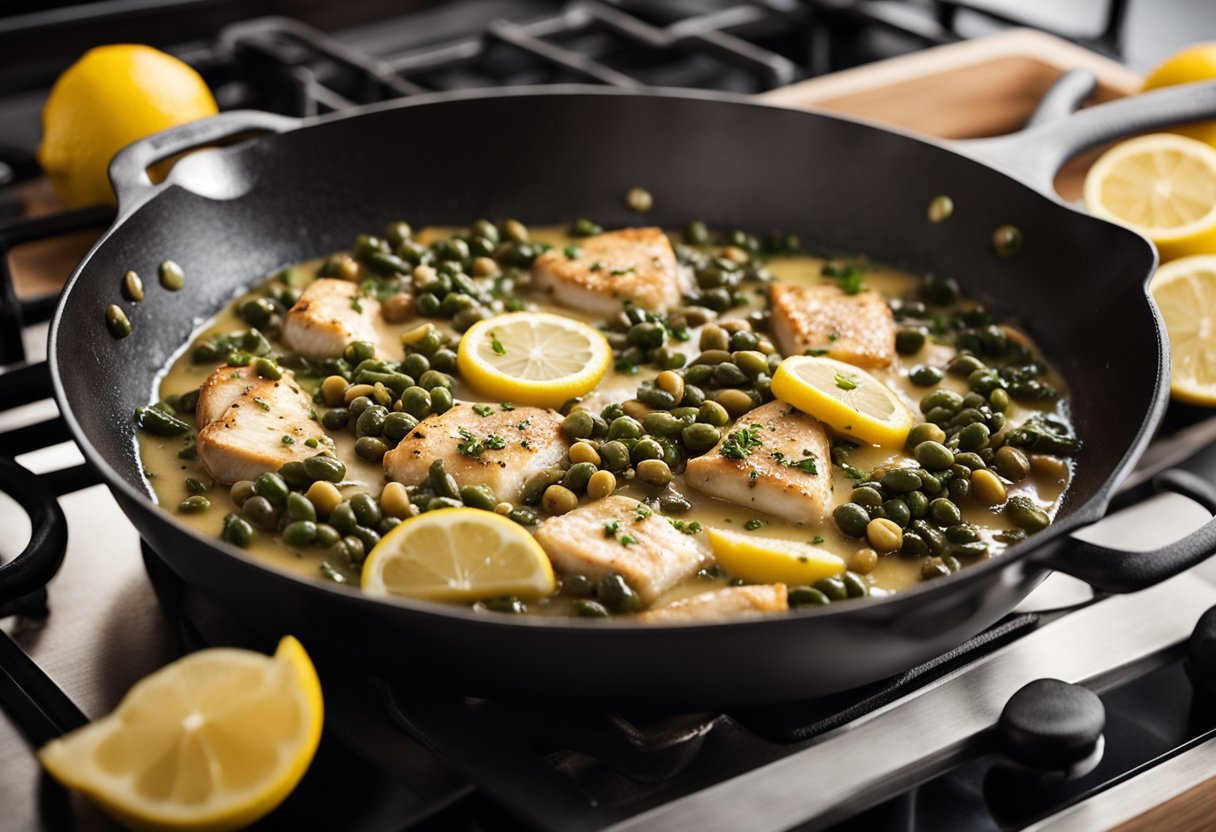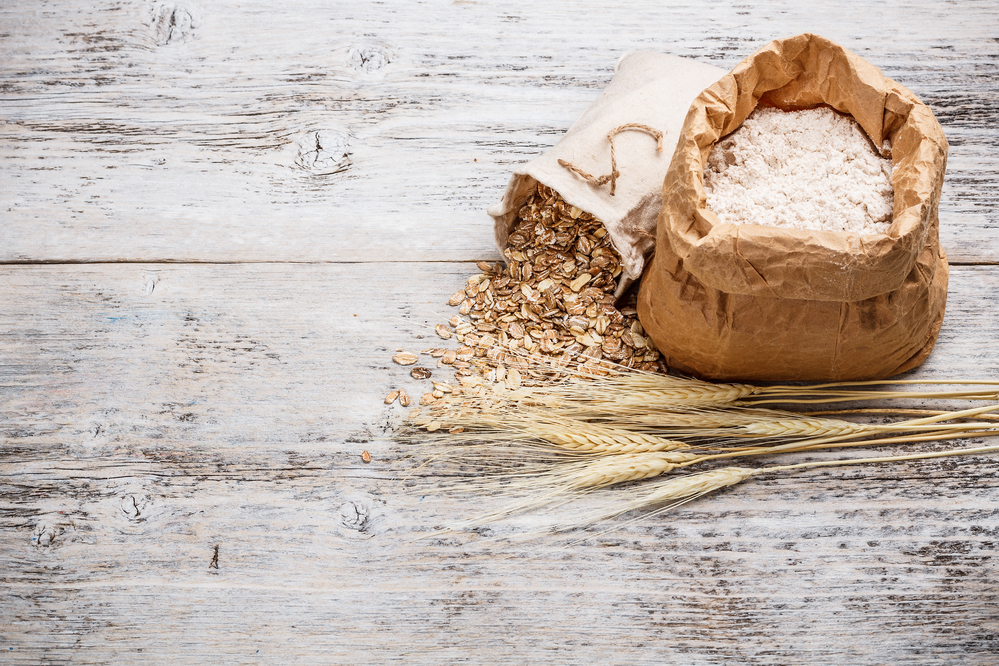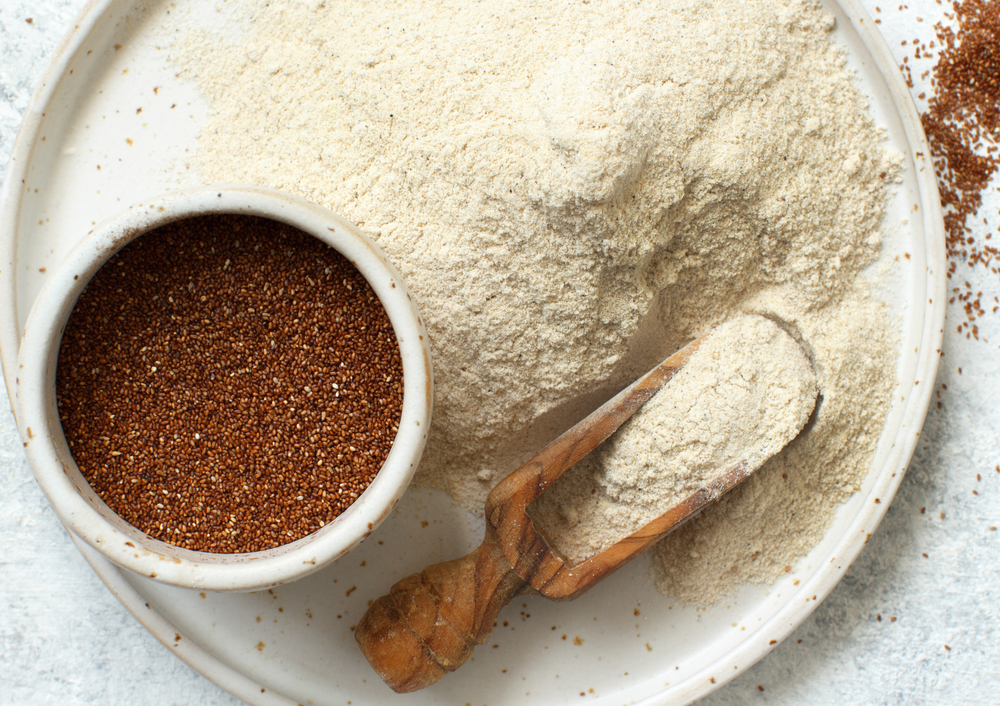Chicken Francese and Chicken Piccata are both classic Italian-American dishes that can sometimes be confused for one another due to their similarities in appearance and flavor profile.
Despite this, there are distinct differences between the two dishes that make each one unique, with specific preparation methods and ingredient choices setting them apart in taste and texture.
Both dishes share the use of tender, boneless chicken breasts which are dredged in a light flour coating, then pan-fried to golden perfection. The sauces, however, are where the principal distinctions emerge.
Chicken Francese typically showcases a light, buttery lemon sauce with hints of white wine, while the Piccata sauce shines with its zesty, tangy blend of lemon juice, white wine, and capers.
Furthermore, the cooking methods, such as the way the chicken is dredged and sautéed also differ between the Francese and Piccata recipes.
Key Takeaways
- Chicken Francese and Chicken Piccata have similarities but differ primarily in the sauce ingredients and preparation methods.
- Francese features a buttery lemon sauce, while Piccata uses a tangy lemon-caper blend.
- These dishes can be customized with various pairings, substitutions, and variations.
History and Origins
Chicken Francese and Chicken Piccata are both well-known and beloved Italian-American dishes that were derived from classic Italian culinary traditions.
These dishes were created by Italian immigrants who had settled in the United States, particularly in New York City, where they combined their traditional recipes with local, easily accessible ingredients.
The origin of Chicken Francese can be traced back to Italy, where it was known as “pollo all francese,” meaning chicken in the French style.
Although it is an Italian dish, the French influence is evident in the method of preparation, involving the light egg batter coating of the chicken. This technique, a common feature in French cuisine, was most likely introduced to Italy through trade or cultural exchanges.
On the other hand, Chicken Piccata has its roots in Italy as well, but this dish has a more distinct Italian identity. It features thin slices of chicken (or sometimes veal) that are sautéed and served with a sauce made of lemon, butter, and capers.
The word “piccata” is derived from the Italian word “piccare,” which means to prick or pierce. This refers to the process of pounding the meat to tenderize it and create an even thickness for cooking.
Both Chicken Francese and Chicken Piccata have become popular Italian-American dishes, adapting and evolving to suit American tastes.
Over time, these dishes have been embraced by a multitude of Italian-American communities, retaining their own unique characteristics while incorporating new ingredients and cooking techniques.
In summary, Chicken Francese and Chicken Piccata share their roots in Italy, but have distinct influences that set them apart. French cooking techniques have influenced the preparation of Chicken Francese, while Chicken Piccata remains a more classic Italian dish.
Both dishes, however, have found a place in the hearts of Italian-Americans and continue to be enjoyed by diners around the world.
Description and Key Differences
Chicken Francese and Chicken Piccata are two popular Italian-American chicken dishes that often find themselves being compared.
While both dishes may seem similar at first glance, there are key differences that set them apart in terms of taste, preparation, and presentation.
Chicken Francese, also known as Chicken Francaise, has a delicate flavor profile. It consists of thinly pounded chicken breasts that are dipped in a flour and egg mixture before being fried until golden brown.
The sauce for Chicken Francese is light, typically made with lemon juice, butter, and chicken broth, which is then poured over the fried chicken.
On the other hand, Chicken Piccata has a slightly stronger flavor due in part to the use of capers and extra lemon juice in its sauce. Similar to Chicken Francese, the chicken breasts are pounded thin in this dish but are only dredged in flour before frying, which creates a slightly different texture.
The Piccata sauce is thicker and tangier, also featuring butter, chicken broth, and sometimes white wine.
Here are some key differences between Chicken Francese and Chicken Piccata:
- Flavor: Chicken Francese has a more delicate flavor, while Chicken Piccata is tangier and stronger due to the addition of capers and extra lemon juice.
- Coating: Chicken Francese is coated in a flour and egg mixture before frying, while Chicken Piccata is only dredged in flour.
- Sauce consistency: Chicken Francese is often accompanied by a lighter sauce, while Chicken Piccata has a thicker sauce.
It is worth noting that these dishes can also be prepared with veal, resulting in Veal Francese and Veal Piccata. The same key differences in flavor, coating, and sauce consistency apply when using veal instead of chicken.
Ultimately, the choice between Chicken Francese and Chicken Piccata comes down to personal preference. Some individuals may appreciate the delicate flavor of Chicken Francese, whereas others may prefer the tangy, robust taste of Chicken Piccata.
Regardless of its variations, both dishes offer a delicious and satisfying meal to those who enjoy Italian-American cuisine.
Ingredients and Preparation
Chicken Francese and Chicken Piccata are both known for their rich, tangy flavors and tender chicken cutlets. They share some similarities in ingredients and preparation, but they also have a few significant differences that set their taste profiles apart.
In preparing Chicken Francese, start with boneless, skinless chicken breasts pounded thin for a tender and delicate texture. The meat is then dredged in seasoned flour and dipped in an egg batter containing eggs, salt, and pepper.
Heat a combination of oil and butter in a pan and then cook the chicken on both sides until golden brown. Once cooked, the pan is deglazed with white wine and chicken broth, allowing the flavors to infuse with the sauce.
Lemon juice is added for a tangy finish, and the sauce is thickened with a little more butter. To complete the dish, garnish with parsley and lemon slices.
On the other hand, Chicken Piccata also calls for thin, boneless, skinless chicken breasts, but they are coated in a mixture of seasoned flour, breadcrumbs, and grated Parmesan cheese. In this recipe, olive oil is typically used for cooking the chicken cutlets to a beautiful golden brown.
The sauce in Chicken Piccata is more savory and includes ingredients like garlic, capers, lemon juice, chicken broth, and white wine. It is thickened with butter and a bit of water to achieve a rich, creamy consistency. Additionally, it incorporates herbs like parsley for both flavor and garnish.
While both dishes use lemon juice, butter, flour, white wine, and chicken broth to create their delectable sauces, the main difference comes from the addition of capers and Parmesan cheese in Chicken Piccata.
These ingredients give it an increased depth of flavor and a bold, tangy profile. As for Chicken Francese, the egg batter creates a lighter, softer texture, and the lemon butter sauce presents a balanced, citrusy taste.
In conclusion, both Chicken Francese and Chicken Piccata are mouthwatering dishes that utilize similar ingredients and techniques while differing in specific elements. The choice between them ultimately comes down to personal preference and desired flavors.
Cooking Methods
Chicken Francese and Chicken Piccata share some similarities in their cooking methods. Both dishes typically involve pan-frying the chicken, which results in a crispy coating and tender meat. However, there are distinct differences between the two preparations that set them apart.
For Chicken Francese, the chicken breasts are first pounded thin and then coated in flour. Next, they are dipped in egg wash, which is a mixture of beaten eggs and sometimes a touch of water. This creates a rich, smooth coating that adheres well to the chicken.
After dipping in egg wash, the chicken pieces are then sautéed in a hot pan with oil or butter over medium-high heat. It is important to cook the chicken evenly on both sides until it has a beautiful golden-brown exterior and is fully cooked inside.
In contrast, Chicken Piccata is prepared by pounding the chicken breasts thin, just like Chicken Francese. However, instead of dipping it in egg wash, the chicken is dredged in flour that has been seasoned with salt and pepper.
This gives the chicken a lighter and drier coating that adheres well to the meat. The chicken pieces are then sautéed in a hot pan with oil or butter over medium-high heat. As the chicken cooks, the coating forms a delicate, crispy texture that is slightly different from the coating on Chicken Francese.
While the cooking methods for the two dishes share some similarities, it is the egg wash in Chicken Francese and the simple flour dredging in Chicken Piccata that primarily differentiate their final textures.
The result is two delicious and distinct dishes, each offering its own unique spin on pan-fried chicken.
Pairings and Substitutions
When it comes to pairing side dishes with chicken francese and chicken piccata, it is essential to choose options that complement the flavors of each dish. Here are some versatile suggestions for pairing these classic Italian dishes with different sides.
1. Potatoes: Mashed or roasted potatoes can accompany both chicken francese and chicken piccata. These sides add a rich and hearty component to the dishes, balancing the tangy flavors of lemon and capers. To make it lighter, consider substituting regular potatoes with sweet potatoes or small baby potatoes.
2. Salad: A simple green salad with a light vinaigrette dressing can add freshness and crunch to the meal. For a Mediterranean twist, add ingredients like olives, feta cheese, and cherry tomatoes to the salad.
3. Pasta: Angel hair pasta is a delightful choice for both dishes, as it absorbs the flavors of the sauce without overwhelming the tender chicken. For those following a gluten-free or low-carb diet, a substitute like spaghetti squash or zucchini noodles could work well.
4. Vegetables: Steamed, sautéed, or roasted vegetables make a vibrant and nutritious addition to these chicken entrees. Asparagus, green beans, and broccoli pair particularly well with the lemony sauces. For a more diverse side dish, opt for a blend of roasted vegetables, including carrots, bell peppers, and zucchini.
5. Rice: A side of rice can be a neutral and satisfying pairing. For a healthier option, substitute white rice with brown or wild rice, or go for a rice pilaf featuring added veggies and herbs.
Whenever possible, try to use fresh, seasonal ingredients to enhance the flavors of your chicken francese or piccata dishes. With these versatile and delicious pairings and substitutions, you can create a balanced and satisfying meal that highlights the distinct characteristics of each dish.
Wine Pairings
When it comes to pairing wines with Chicken Francese and Chicken Piccata, choosing the right wine can enhance the flavor of the dish exponentially. Here are some recommendations to create a delightful and complementary dining experience.
Chardonnay is a versatile wine that pairs well with both Chicken Francese and Chicken Piccata. Its buttery and oaky characteristics can balance the rich, lemony flavors of these dishes.
For a particularly well-matched wine, consider a lightly oaked Chardonnay, which will provide some subtle creaminess that will not overwhelm the dish’s flavors.
Sauvignon Blanc is another great option, particularly if you’re looking for a lighter, crisper wine to accompany Chicken Piccata or Chicken Francese. The acidity and citrus notes in the Sauvignon Blanc can cut through the richness of both dishes, refreshing the palate between bites.
A French or New Zealand Sauvignon Blanc will do the trick, as the former offers mineral and floral aromas while the latter is known for its tropical fruit flavors.
In addition to Chardonnay and Sauvignon Blanc, other wines can also pair harmoniously with Chicken Francese and Chicken Piccata. Here are a couple of alternatives to explore:
- Pinot Grigio: This light, crisp white wine has bright acidity and subtle fruit flavors, which can complement the lemony sauce of both dishes without overpowering them.
- Vermentino: A lesser-known white wine from Italy, Vermentino has a zesty, citrusy profile that can enhance the flavors in Chicken Francese and Chicken Piccata while maintaining a clean and refreshing balance.
Remember that personal taste also plays a significant role in wine pairing, so feel free to experiment and discover your perfect match for Chicken Francese and Chicken Piccata.
Nutritional Value and Dietary Considerations
Chicken Francese and Chicken Piccata are two popular dishes that feature similar ingredients, but with slight variations. When it comes to nutritional value and dietary considerations, both dishes offer a range of benefits and considerations.
Chicken Francese is made with boneless, skinless chicken breast or chicken thighs that are lightly coated in flour before being cooked. This method of preparation results in a dish that is relatively low in fat.
The lemon-butter sauce used in Chicken Francese is rich in flavor, but it can also be high in calories due to the use of butter. However, using a moderate amount of sauce can help maintain a balance between taste and nutrition.
Chicken Piccata also uses boneless, skinless chicken breasts or thighs as its main protein. The chicken is prepared in a similar manner, with a light flour coating. The Piccata sauce, made with lemon, capers, and butter, is slightly tangier in flavor compared to the Francese sauce.
Although the addition of capers adds some sodium to the dish, it remains a comparatively healthier option due to its lower fat content.
In terms of nutritional value, both boneless, skinless chicken breasts and thighs provide an excellent source of protein. A 100-gram serving of chicken breast contains approximately 31 grams of protein, while an equivalent serving of chicken thigh contains about 26 grams.
Here is a comparison table of the approximate nutritional value per 100 grams of boneless, skinless chicken breast and chicken thigh:
| Nutrient | Chicken Breast | Chicken Thigh |
|---|---|---|
| Calories | 165 | 209 |
| Protein | 31g | 26g |
| Fat | 3.6g | 13g |
| Saturated Fat | 1g | 3.5g |
| Sodium | 74mg | 88mg |
| Cholesterol | 85mg | 94mg |
When considering dietary needs, both Chicken Francese and Chicken Piccata can be incorporated into a balanced meal plan. For those who are monitoring their fat intake, opting for chicken breast would be a healthier choice.
Moreover, adjusting the amount of butter used in the sauces can also help tailor the dishes to individual nutritional preferences.
In conclusion, both Chicken Francese and Chicken Piccata have their unique flavor profiles and nutritional values. By making mindful choices regarding ingredients and portion sizes, these dishes can be enjoyed while maintaining a healthy diet.
Convenience and Versatility
Chicken Francese and Chicken Piccata are two popular Italian-American dishes perfect for busy weeknights. With their easy-to-make nature and delectable taste, these options are suitable for anyone looking for a quick and easy meal.
Both dishes can be prepared in under an hour and feature a tangy, flavorful sauce that pairs well with various side dishes.
Chicken Francese and Chicken Piccata make delightful weeknight dinners when served with pasta, rice, or vegetables. These dishes can be easily adapted to accommodate different preferences and dietary restrictions.
Chicken Francese is known for its light egg batter and lemon butter sauce. This dish is simple to make yet yields impressive results, making it perfect for a weeknight dinner. The ingredients are typically found in most households, adding to its convenience.
Chicken Piccata features a breaded chicken cutlet with a tangy lemon, butter, and caper sauce. This dish can be equally convenient as it shares a few similar ingredients with Chicken Francese.
The addition of capers gives the dish its distinctive flavor, setting it apart from other Italian-American meals.
In summary, the convenience and versatility of Chicken Francese and Chicken Piccata make them excellent choices for fast meals on busy weeknights. Their unique flavor profiles and adaptability to various sides allow them to be enjoyed by a wide range of people.
Variations and Twists on the Classics
Chicken Francese and Chicken Piccata are both Italian-American dishes that share similarities in taste and texture. However, they also have their unique twists and variations, making each dish stand out in its distinct ways.
Piccata is an Italian-American dish that originally hails from Milan. It is often prepared with veal, but chicken has become a popular alternative. The defining characteristic of piccata is its lemon and caper sauce. This rich sauce combines a lemon base with capers, white wine, and butter, resulting in a tangy, yet savory, taste.
Some variations of piccata sauce include the addition of garlic, shallots, or red pepper flakes to add an extra kick. Fresh parsley is commonly sprinkled on top to add a touch of brightness and enhance the taste.
While piccata is known for its lemon and caper sauce, Chicken Francese offers a slightly different experience, focusing more on the texture of the dish.
The chicken is dipped in an egg wash and dredged in flour to ensure a crispy exterior with a tender interior. In contrast, Chicken Piccata is coated with flour alone. Chicken Francese also involves a lemon-based sauce, but it is typically thicker with less emphasis on the capers.
Some variations of both dishes involve adjusting the ingredients of the sauce or using different types of protein. For instance, Ina Garten, a popular chef, presents a unique spin on piccata by using fish, topped with a lemon-herb sauce.
Comparatively, Chicken Francese can also be prepared with veal or fish to create a versatile dish. Adjusting the thickness or tanginess of the sauce can contribute to the overall texture and taste experience in both dishes.
In summary, Chicken Francese and Chicken Piccata are two Italian-American classics that showcase a delightful combination of lemon-based sauces with tender proteins. Various adaptations involving sauce components, proteins, or cooking techniques add twists and variations to make each dish unique.
The secret lies in balancing the tangy flavors and maintaining the right texture, ultimately creating a satisfying culinary experience.
Frequently Asked Questions
What are the main differences between Chicken Francese and Chicken Piccata?
Chicken Francese and Chicken Piccata are both Italian-American dishes featuring thin, pan-fried chicken breasts. The main differences lie in the ingredients and sauces.
Chicken Francese uses an egg and flour batter, resulting in a slightly thicker coating, while Chicken Piccata uses a lighter flour coating.
The sauce for Chicken Francese typically includes lemon juice, chicken broth, and white wine, whereas Chicken Piccata’s sauce is based on lemon juice, capers, and butter.
How does the cooking process differ for each dish?
In Chicken Francese, the chicken breasts are first dipped in a mixture of beaten eggs and grated cheese, then dredged in flour before being pan-fried.
In Chicken Piccata, the chicken is simply dredged in seasoned flour and then pan-fried. Both dishes are completed by simmering the cooked chicken in their respective sauces.
What are the key ingredients in Chicken Francese and Chicken Piccata?
Key ingredients in Chicken Francese include boneless, skinless chicken breasts, eggs, flour, lemon juice, chicken broth, and white wine. For Chicken Piccata, the main ingredients are boneless, skinless chicken breasts, flour, lemon juice, capers, and butter.
What is the difference between the sauces used in Chicken Francese and Chicken Piccata?
The sauce for Chicken Francese is made from lemon juice, chicken broth, and white wine, creating a light yet flavorful mixture. In contrast, Chicken Piccata’s sauce is a combination of lemon juice, capers, and butter, resulting in a tangy and rich taste.
Which dish is considered healthier between Chicken Francese and Chicken Piccata?
Since both dishes use similar ingredients and cooking techniques, their nutritional content is quite comparable.
However, Chicken Piccata could be considered marginally healthier due to its lighter flour coating and use of capers, which add flavor without many additional calories. Nonetheless, the overall healthiness of each dish ultimately depends on the specific preparation and serving size.
How do Chicken Piccata, Francese, and Marsala compare with one another?
Chicken Piccata, Francese, and Marsala are all Italian-American dishes featuring thinly sliced, pan-fried chicken breasts. The main differences are in the sauces and ingredients.
Chicken Piccata has a tangy lemon-caper sauce, Chicken Francese features a light lemon-wine sauce, and Chicken Marsala is served with a rich, earthy mushroom and Marsala wine sauce.
All three dishes have a unique and distinctive flavor profile, making them popular choices among diners who appreciate Italian cuisine.







